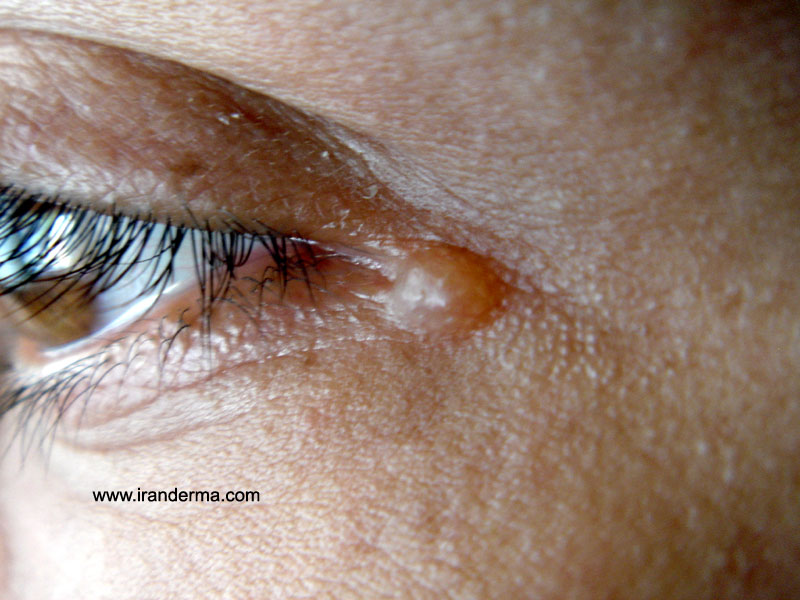IRANDERMA |
|
Quiz: January 2007 |
What is your diagnosis for this 35-year-old woman
who presented with an asymptomatic lesion on the lateral canthus?
Diagnosis: Hidrocystoma
Hidrocystoma
Keywords: Sweat glands tumors, Eccrine and apocrine hidrocystomas, apocrine cystadenoma
Both eccrine hidrocystomas and apocrine cystadenomas are morphologically related cystic sweat gland tumors. Both occur most often on the face as small dome-shaped translucent papules, which may have a bluish hue.
Apocrine Hidrocytoma (apocrine retention cyst)
Apocrine hidrocytoma or cystadenoma was described by Mehregan1 as a single benign tumor occuring chiefly on the face (usually solitary and are most common around the eye). The lesion is a dome-shaped, smooth-surfaced, translucent nodule, frequently bluish to brownish in color. They may be larger and darker blue than the eccrine variety and thus may resemble a blue nevus. Some prefer the term apocrine cystadenoma reflecting the opinion that these are secretory neoplasms rather than cystic dilations. Histologically there are several cystic spaces lined by columnar cells showing decapitation secretion and resting on flattened myoepithelial cells.
Differential Dg: pigmented nevus, melanoma, blue nevus or a cystic basal cell carcinoma.
Eccrine hidrocystomas
Eccrine hidrocystomas may be multiple over the cheeks and eyelids and may enlarge with heat stress. Incision results immediate disappearance of the cyst, with production of a clear drop of fluid. Histologically these appear to be true sweat retention cysts in that there is a single cystic cavity lined by one or two layers of small cuboidal cells. Eccrine tubules and duct may connect to the cyst from below.
De Viragh et al.2 reveals three distinct types of tumors, in contrast to the conventional distinction of only eccrine hidrocystomas and apocrine cystadenomas. To elucidate their cellular differentiation they examined by immunohistochemistry the expression of keratins and of human milk fat globulin 1 in 12 of each of these tumors, diagnosed using established conventional histological criteria. All tumors diagnosed as apocrine cystadenomas by these criteria were characterized by a keratin pattern of secretory type. In addition, they expressed human milk fat globulin 1. Tumors diagnosed as eccrine hidrocystomas expressed a keratin pattern of excretory type. A part of the tumors with an excretory keratin pattern expressed human milk fat globulin, while others did not. Some presumed eccrine hidrocystomas expressed the very same antigens as apocrine cystadenomas Apocrine cystadenomas differentiate towards the secretory coil of apocrine sweat glands. Presumed eccrine hidrocystomas may represent cystic tumors of the eccrine sweat duct, or they may represent cystic tumors of the apocrine duct. Thus, the name hidrocystoma should be used without further specification of an eccrine or apocrine nature, unless certainty is reached by immunohistochemical characterization. Also, hidrocystomas often prove to be histologically misdiagnosed apocrine cystadenomas because of a flattened cyst wall secondary to increased intraluminal pressure.
References:
1. Mehregan AH. Mehregan AH. Apocrine Cystadenoma: A clinicopathologic study with spacial reference to the pigmented variety. Arch Dermatol. 1964 Sep;90:274.9.
2. de Viragh PA, Szeimies RM, Eckert F. Apocrine cystadenoma, apocrine hidrocystoma, and eccrine hidrocystoma: three distinct tumors defined by expression of keratins and human milk fat globulin. J Cutan Pathol. 1997 Apr;24(4):249-55.
Comment: Mehrdad Mehravaran, M.D., Dermatologist. / Szeged- Hungary
Thanks to Mehrdad for his valuable comments. It must be mentioned that although apocirne hidrocystomas are usually solitary and eccrrine hidrocystomas are usually multiple, but this is not a rule. We've reported a case of multiple apocirne hidrocystomas before; for those who are interested this link may help; http://www.ams.ac.ir/AIM/0363/020.pdf.
Omid Zargari, MD, Rasht / Iran
ايران درما |
